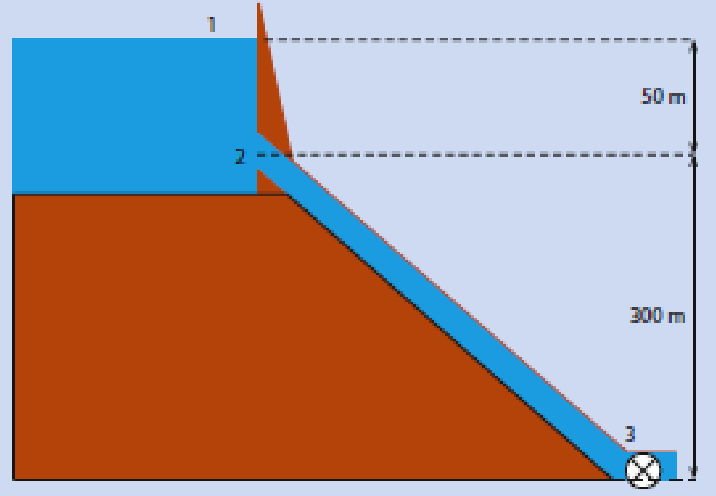In this problem, the two points that are used in the application of the Bernoulli equation are points 1 and 3. As @V.F. correctly points out, the pressures at points 1 and 3 are both atmospheric, so these pressures cancel. The fluid velocity at point 1 is essentially zero, and the elevation z at point 1 is 350 m above the datum, situated at point 3.
For point 3, the elevation z is 0, and the velocity is $v_3$. This all leads to the equation presented in the OP. And, of course, the continuity equation is not violated, since $v_2=v_3$.
Of course, the velocity at point 2 is not equal to $\sqrt{2g\times 50}$ because the pressure at point 2 is not equal to the pressure at point
Before completing this solution, it is of interest to check the pressure at point 2 to ascertain whether the fluid is cavitating. Applying Bernoulli to points 2 and 3, we have:
$$p_2+\rho g(300)+\frac{1}{2}\rho v_2^2=p_3+\frac{1}{2}\rho v_3^2$$Solving for $p_2$ yields $$p_2=-300\rho g$$This is well below the value of $-10\rho g$ which would be required to cause cavitation. Since the fluid will be cavitating, the tube between points 2 and 3 will not be running full, and there will be a vacuum of nearly $10 \rho g$ in the empty section above the column of fluid in the tube (situated above point 3). The pressure at point 2 will be $p_2=-10\rho g$. Then, applying the Bernoulli equation to points 1 and 2, we would have:
$$0+50 \rho g+0=-10\rho g+0+\frac{1}{2}\rho v_2^2$$So, $$v_2=\sqrt{120 \rho g}$$We can now calculate the elevation of the fluid level in the partially filled column between points 2 and 3. Applying the Bernoulli equation in conjunction to the continuity equation to the column gives:
$$p_2+\rho g h+\frac{1}{2}\rho v_2^2=p_3+\frac{1}{2}\rho v_3^2$$or$$-10\rho g+\rho g h=0$$Therefore, as one might expect, the height of the column will be 10 meters. Because of the cavitation, the other 290 meters will essentially be vacuum (more precisely, at the absolute vapor pressure of water at the system temperature).

